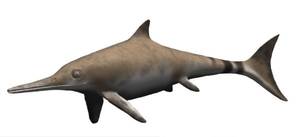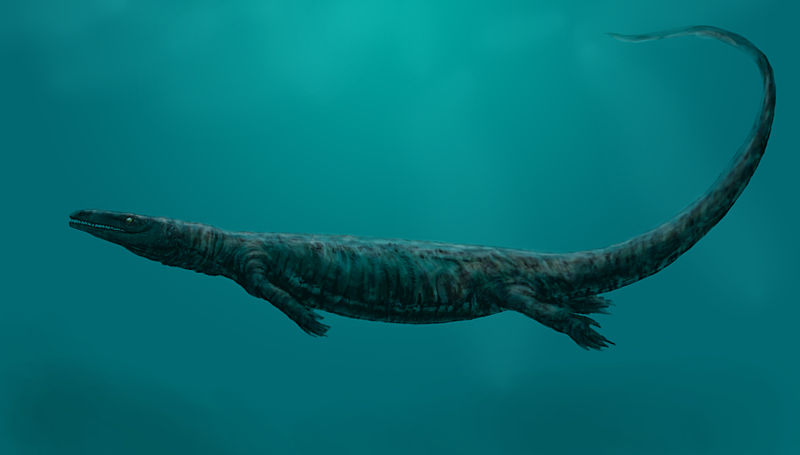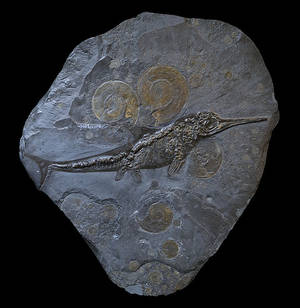The age of marine reptiles
Interview with
Sarah - Our next stop is not the Ordovician seas. Instead, we're jumping forward over 200 million years, past the evolution of the first sharks, with their mysterious tooth whorls and head ornaments. Past the first appearances of ray finned fish, and the lobe finned fish that travelled into freshwater and eventually onto the land, and we find ourselves in the Mesozoic, the time of the great ocean reptiles.
 Hilary - If you were to dive into the sea during the Mesozoic you would probably see a whole range of invertebrates swimming around including relatives of the squid today like ammonites and belemnites, swimming past you. On the sea bed you'd see familiar things, clams and mussels, maybe corals and brachiopods which are not very common today but they were much more common back then. And you'd probably also chance a sighting of a marine reptile. During the Mesozoic there were at least 18 different groups of marine reptiles that invaded the sea, from all different areas of the reptile tree. And they're a really diverse group of animals.
Hilary - If you were to dive into the sea during the Mesozoic you would probably see a whole range of invertebrates swimming around including relatives of the squid today like ammonites and belemnites, swimming past you. On the sea bed you'd see familiar things, clams and mussels, maybe corals and brachiopods which are not very common today but they were much more common back then. And you'd probably also chance a sighting of a marine reptile. During the Mesozoic there were at least 18 different groups of marine reptiles that invaded the sea, from all different areas of the reptile tree. And they're a really diverse group of animals.
Sarah - Hilary Ketchum from the University of Cambridge. By the start of the Mesozoic, around 250 million years ago, reptiles were already diversifying on land - it's known as the 'Age of Reptiles', and includes the Triassic, Jurassic and Cretaceous periods, when the dinosaurs ruled the land. So what drove so many reptile groups back into the oceans?
Hilary - Following the end Permian mass extinction there was very little left in the water. Over 90% of all species particularly in the marine realm were badly hit by extinction and this left an open space for lots of reptiles to invade particularly when the sea level rose and it increased productivity in the water.
Sarah - And one of those groups of marine reptiles that flourished was the ichthyosaurs...
Hilary - They're called ichthyosaurs because that means fish lizard, but the early  ichthyosaurs didn't look much like fish. That name was based on later ones from middle Jurassic onwards that were first found by palaeontologists. They have a very fish-like body outline, with a conical snout, lots of conical teeth and a fish-like tail which propels them through the water. But the earlier ichthyosaurs were much more eel-like in shape, they were much more diverse. Some of them got to 20metres in length. And these ichthyosaurs originated in the early Triassic about 245 million years ago at a time of really high sea level, when the sea invaded the continental shelf which provided a lot more productivity and encouraged a lot more reptiles to invade the sea. And that's why we get so much diversification of marine reptiles during that period.
ichthyosaurs didn't look much like fish. That name was based on later ones from middle Jurassic onwards that were first found by palaeontologists. They have a very fish-like body outline, with a conical snout, lots of conical teeth and a fish-like tail which propels them through the water. But the earlier ichthyosaurs were much more eel-like in shape, they were much more diverse. Some of them got to 20metres in length. And these ichthyosaurs originated in the early Triassic about 245 million years ago at a time of really high sea level, when the sea invaded the continental shelf which provided a lot more productivity and encouraged a lot more reptiles to invade the sea. And that's why we get so much diversification of marine reptiles during that period.
Towards the end of the Triassic the sea level started to fall but by that time they'd evolved their typical fish-like body plan, they'd started to invade the open oceans, and that's probably what helped them survive the end-Triassic mass extinction which was caused we think by a marine regression, so the sea levels fell. But probably because they'd evolved this open ocean-going body plan they managed to survive that.
 Sarah - However, the ichthyosaurs, and the other marine reptile groups, including the long-necked plesiosaurs, heavy-set pliosaurs and the mosasaurs were not so lucky towards the end of the Mesozoic. Ichthyosaurs died out around 90 million years ago, and it's not clear why, though competition from certain types of shark could be to blame. But almost all marine reptiles were wiped out at the End Cretaceous mass extinction, 65 million years ago - the extinction that also put paid to the dinosaurs on land, that was potentially caused by an asteroid impact. The only survivors of this once diverse marine reptile group live on today as sea turtles and crocodiles and their relatives. As on land, after the large reptiles were wiped out in the oceans, mammals filled some of the ecological niches left behind. So now we see killer whales and dolphins, where once we saw pliosaurs and ichthyosaurs.
Sarah - However, the ichthyosaurs, and the other marine reptile groups, including the long-necked plesiosaurs, heavy-set pliosaurs and the mosasaurs were not so lucky towards the end of the Mesozoic. Ichthyosaurs died out around 90 million years ago, and it's not clear why, though competition from certain types of shark could be to blame. But almost all marine reptiles were wiped out at the End Cretaceous mass extinction, 65 million years ago - the extinction that also put paid to the dinosaurs on land, that was potentially caused by an asteroid impact. The only survivors of this once diverse marine reptile group live on today as sea turtles and crocodiles and their relatives. As on land, after the large reptiles were wiped out in the oceans, mammals filled some of the ecological niches left behind. So now we see killer whales and dolphins, where once we saw pliosaurs and ichthyosaurs.
So, to recap our story so far. We've seen how life first began in the oceans, in the form of microbes, thriving on a planet very different from how it is now. Then, 3 billion years later, an explosion of complex life, and we start to see the beginnings of animal groups we see across the globe today. Jumping to the Mesozoic, we see some of the largest creatures ever to live in the oceans, and then see almost all of them wiped out along with the dinosaurs.
- Previous Early humans get a taste for seafood
- Next Explosive diversity










Comments
Add a comment